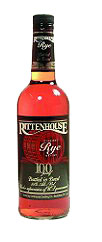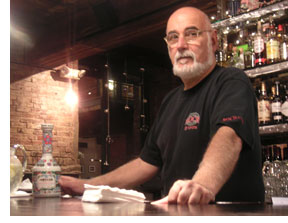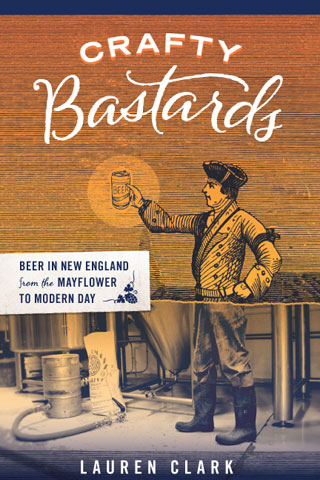December 27th, 2006
I don’t remember my family having a traditional holiday drink. My parents were never eggnog or punch types. For a few years running we put Bailey’s in our late-morning coffee, but that trend petered out. Over the past several years, though, I have brought a beverage to the table that has pretty much become mandatory: Sierra Nevada Celebration Ale. A beer introduced 25 years ago by one of America’s biggest microbreweries may not seem very original to the drinks aficionado, but that’s what I like about the stuff. Like Chex Party Mix, it’s just familiar enough but just special enough to make it onto the books as a holiday foodstuff that pleases a crowd and signifies Special Times. What does this beer have to do with Boston? Not much, other than the fact that every copper-colored strong ale redolent of citrusy West Coast hops — like the Cambridge Brewing Co.’s winter special, Big Man Ale — is a child of Sierra Nevada Celebration.
In the Fog of Christmas, one’s psyche can get pretty tossed around. That’s why I’ve begun a new, post-holiday, ritual: going to No. 9 Park for a Tom and Jerry. This is an old-time winter punch that hardly any bar in America has mixed in decades because it involves separating eggs and boiling milk. (Go here to see “libation goddess” Audrey Sanders’ recipe.) When you order a T&J at No. 9, the bartender will take his time and make it right, so be prepared to wait a good 10 minutes. Trust me, it’s worth it. When the drink is placed in front of you in its traditional gold-lettered mug, bring it up to your lips, then close your eyes and take a sip. I’m not kidding about the close-your-eyes part. Rum, brandy and spices encased in a fluffy batter of hot milk and whipped egg whites will transport you to a peaceful place, bringing joy to the world and good will toward men.
Permalink | No Comments | Filed under Beer, Cocktails, Rum |
December 20th, 2006
 Fellow Boston drinks writer and Weekly Dig contributor MC Slim JB emailed me recently asking if I knew where to buy bitters locally. It seems this question came up recently on the Boston Area section of the Chowhound board. I told him what I knew: Eastern Standard stocks extra bottles of orange bitters (Fee Bros. and Regan’s) and Peychaud’s bitters to sell to those who ask. Christina’s spice shop in Inman Square, Cambridge sells Fee Bros. orange bitters (and also orange flower water for your homemade grenadine). Also, I seem to remember that Blanchard’s liquor store in Allston (617-782-5588) stocks Fee Bros. orange bitters and Peychaud’s, but you should double-check before you go.
Fellow Boston drinks writer and Weekly Dig contributor MC Slim JB emailed me recently asking if I knew where to buy bitters locally. It seems this question came up recently on the Boston Area section of the Chowhound board. I told him what I knew: Eastern Standard stocks extra bottles of orange bitters (Fee Bros. and Regan’s) and Peychaud’s bitters to sell to those who ask. Christina’s spice shop in Inman Square, Cambridge sells Fee Bros. orange bitters (and also orange flower water for your homemade grenadine). Also, I seem to remember that Blanchard’s liquor store in Allston (617-782-5588) stocks Fee Bros. orange bitters and Peychaud’s, but you should double-check before you go.
Aromatic bitters like Angostura, Peychaud’s and all their defunct brethren are such a cool and mysterious part of cocktail history. They were medicinal potions made of top-secret blends of roots, herbs and other botanicals and consumed by the drop in a glass of whiskey or brandy to ease digestive troubles. “The Cocktail” wouldn’t exist without bitters. (See this Martini Republic post by Ted Haigh for more background and info on bitters.) After my conversation with MC Slim JB, I started some long-overdue research on bitters, particularly recipes one might be able to re-create at home. I remembered that there was a recipe in Haigh’s Vintage Spirits & Forgotten Cocktails for Boker’s bitters, a New York product that disappeared around the turn of the 20th century. Haigh reconstructed the Boker’s formula from a recipe he found in The Scientific American Cyclopedia of Receipts, Notes & Queries. Here it is:
3/4 ounce quassia chips
3/4 ounce powdered catechu
1/2 ounce cardamom
1 ounce dried orange peel
Macerate for 10 days in 1 quart strong whiskey. Filter and add 1 gallon of water. Color with Mallow or Malva flowers.
If anyone finds a local source for quassia chips, catechu and Malva flowers, let me know. Strangely, I didn’t find any of these at the well-stocked Christina’s spice shop mentioned above, but I did find Tonka beans there. Tonka beans were an ingredient in another defunct brand of bitters that cocktail geeks have been trying to recreate for years and that are probably worth more than their weight in gold on eBay: Abbott’s Bitters. Apparently, a Manhattan made with Abbott’s bitters is the Best Cocktail You Will Ever Drink. Robert “Drinkboy” Hess and some of the correspondents on his forum actually had a gas chromatograph done on an old bottle of Abbott’s and, for the most part, isolated the components of the formula. Read their recipe and ongoing discussion about Abbott’s here. According to Hess and others, one of Abbott’s key ingredients, Tonka bean, was banned by the FDA decades ago because it can cause intestinal bleeding (!). And yet, there they were: small plastic bags of Tonka beans on sale at Christina’s for $4.50. Now if I can only track down Pimenta Racemosa Bay leaves and Benzoin resin…
Permalink | 12 Comments | Filed under Bitters, Drinking supplies |
December 13th, 2006
 Oh no. Smell that? It’s the latest liquor trend: top-shelf rye whiskey. We’re talking $50, $100 bottles of the stuff that, if you ordered it in a bar a few years ago, you were probably an 80-year-old man drinking Canadian Club. In the average American bar, Canadian whiskey is what you get when you order rye, because U.S. rye distilleries dwindled and nearly died out in the decades following Prohibition.
Oh no. Smell that? It’s the latest liquor trend: top-shelf rye whiskey. We’re talking $50, $100 bottles of the stuff that, if you ordered it in a bar a few years ago, you were probably an 80-year-old man drinking Canadian Club. In the average American bar, Canadian whiskey is what you get when you order rye, because U.S. rye distilleries dwindled and nearly died out in the decades following Prohibition.
“Now, though, in a turnabout, the prospects for rye have brightened considerably,” wrote the New York Times’ Eric Asimov late last month (All but Lost, Rye Is Revived As the Next Boutique Find). The article reviewed several ryes, at least half of which were between $65 and $140. “Fueled by the same sense of curiosity and geeky connoisseurship that gave birth to the microbrew industry, the single-malt avalanche and myriad small-batch bourbons, rye has been resurrected by whiskey lovers who want to preserve its singular, almost exotic essence.”
Oh crap.
Look, I’m one of those geeky connoisseurs. I used to be in the microbrew industry. I have six different kinds of bourbon in my house right now. And I admit my life changed a little the first time I tasted Van Winkle Family Reserve 13-year rye. That’s why I now have four different kinds of rye in my house, mingling with the bourbon bottles. But articles like this give me a sinking feeling. I mean, $140 rye? Who’s drinking this stuff? Maybe a handful of geeky connoisseurs, but mostly New York Times tasting panels and free-spending poseurs. And the worst thing is that prices are only going to skyrocket, because the good stuff is scarce.
Which brings me to Rittenhouse Straight 100-proof and Andy Kilgore. Rittenhouse Straight 100-proof (which actually made the NYT panel’s top 10) is a rye that can be purchased for under $20. Andy Kilgore is a bartender at Chez Henri who understands that rye is a traditionally rough spirit that resourceful bartenders of yore molded into cultured cocktails like the Algonquin and the Old-Fashioned. He demonstrated this to me and a few friends recently. First, he gave us a taste of Rittenhouse neat. Whoa! It made me want to pull out my six-shooter and walk 10 paces. Then he used it to mix “old-fashioned” Old-Fashioneds. Forget about the muddled maraschino cherry and orange slice, the big blast of soda water and the bourbon, he said. In a heavy rocks glass, he muddled Angostura and orange bitters with sugar and a bit of water, then added chilled Rittenhouse and finished the drink with flamed lemon peel. Oh my god, what a good drink. It was like the rye had donned a tuxedo and combed its hair. Isn’t it always the grizzled tough guy who looks hottest in a new suit, anyway?
Permalink | No Comments | Filed under Bartenders, Cocktails, Whiskey |
December 7th, 2006
 Bartender Profile
Bartender Profile
If there’s one thing 40 years of tending bar has taught Reggie St. Paul, it’s the importance of paying attention to customers — and I don’t mean listening for hours to some guy complain about his ex-wife. I mean picking up on little cues and treating people accordingly. For instance, though I’m only a sporadic Blue Room customer, he remembers that when I order a glass of wine, I never request a particular grape or brand; instead, I defer to the bartender’s suggestion. Reggie never has to think about it, he just selects a bottle, pours me a taste, and it’s always just right. He is also skilled at subtly imposing a standard of behavior. Once I saw a couple come in and brusquely order Jack and Cokes, saying they were in a hurry to catch a movie at the nearby theater. They fidgeted on their barstools, and the woman reeked of perfume. Without missing a beat, Reggie showed them how uncool they were being: he asked for ID, though they were well into their 30s.
Reggie started tending bar in 1965 to augment the meager salary he was earning as a high school teacher and soon abandoned the teaching gig altogether, with no regrets. One of his first jobs was at Lennie’s on the Turnpike, a legendary jazz bar in West Peabody where “15 bucks in tips was a good night.” Nice tradeoff, though — he got to see Duke Ellington, Miles Davis, Stan Getz and Bill Evans, among other greats. Booze trends were a bit different back then. Reggie remembers preparing for an average shift by pre-mixing a couple gallons each of Martinis and Manhattans. Everyone drank gin and rye whiskey, no one drank vodka, and wine came in a jug. These days, when you go to the Blue Room, Reggie will offer to mix you his signature 5 Star Sidecar: Metaxa 5-Star Brandy, fresh sour, and Cointreau served straight up in a glass with a sugared rim. For my money, though, I’ll take the crisp, cool Martini he’s perfected over the past 40 years.
Hometown
Medford, MA
Past bartending jobs
Lennie’s, 1965-71; Casablanca, 1971-89; the Blue Room, 1991-present
First drink you ever had
Sloe Gin Fizz
Favorite bar in Boston other than your own
B-Side Lounge, Green Street
Drink you most like to make
5 Star Sidecar
Drink you least like to make
Old-Fashioned
What you drink at the end of your shift
Beer
If I weren’t a bartender, I’d be…
A teacher
A bartender’s best friend is…
His or her ability to improvise in any situation
A bartender’s worst enemy is…
Pre-judging his guests
Drink for a hot summer day
White Sangria
Drink for a cold winter night
Spanish Coffee
The best thing about drinking in Boston is…
2 a.m. closing
The worst thing about drinking in Boston is…
2 a.m. closing
Permalink | No Comments | Filed under Bartenders |
December 4th, 2006
Are you whiskey-curious? Want to experiment with the amber liquor but aren’t ready to bear the full brunt of its kick? Try a Frisco: 1 1/2 oz rye, 3/4 oz Benedictine and 3/4 oz lemon juice shaken over ice and strained into a stemmed glass. Its prominent citrus and herbal flavors tame the rye into submission, making the Frisco the perfect drink for preliminary explorations. Indeed, this golden cocktail was my first love, a tasty gateway to subsequent adventures with Manhattans, Red Hooks, and Sazeracs. I still love the Frisco and regularly recommend it to all whiskey-curious people I meet. Since the drink has long been on the B-Side Lounge’s comprehensive cocktail menu, and since many bartenders in Boston and Cambridge have completed a stint there at some point in their careers, finding this drink in a local bar isn’t as far-fetched as you’d think.
Note: As is the case with many cocktails, the recipe above (which is the one B-Side uses) is one of many that list varying proportions of rye, lemon juice and Benedictine. Early recipes appear to have only called for a lemon twist. In any case, the recipe here is damn tasty and probably the most user-friendly for the beginner.
Permalink | 1 Comment | Filed under Cocktails, Liqueur, Whiskey |
 Fellow Boston drinks writer and Weekly Dig contributor MC Slim JB emailed me recently asking if I knew where to buy bitters locally. It seems this
Fellow Boston drinks writer and Weekly Dig contributor MC Slim JB emailed me recently asking if I knew where to buy bitters locally. It seems this  Oh no. Smell that? It’s the latest liquor trend: top-shelf rye whiskey. We’re talking $50, $100 bottles of the stuff that, if you ordered it in a bar a few years ago, you were probably an 80-year-old man drinking Canadian Club. In the average American bar, Canadian whiskey is what you get when you order rye, because U.S. rye distilleries dwindled and nearly died out in the decades following Prohibition.
Oh no. Smell that? It’s the latest liquor trend: top-shelf rye whiskey. We’re talking $50, $100 bottles of the stuff that, if you ordered it in a bar a few years ago, you were probably an 80-year-old man drinking Canadian Club. In the average American bar, Canadian whiskey is what you get when you order rye, because U.S. rye distilleries dwindled and nearly died out in the decades following Prohibition. Bartender Profile
Bartender Profile